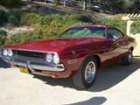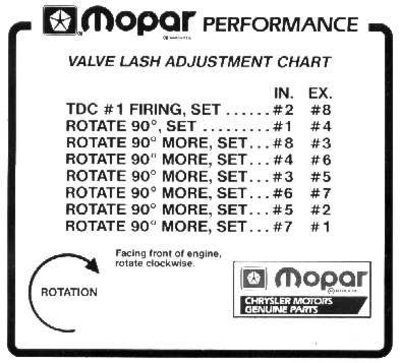I replaced the rocker arms on my 340 a few years back along with a Factory Chrysler purple shaft cam and hydraulic lifters. The adjustable rockers are from Sig Erson along with matching pushrods.
I am checking the valve clearance do to a faint ticking and can't remember exactly how many turns past 0.00 lash too properly adjust them. Crane cams web site says 1/2 to 1 full turn on the adjusting nut to obtain .020 -.060 compression within the tappet. When I tried this it actually compressed (opened) the valve. I assume not all hydrualic tappets are the same.
Does anyone out there use the older (late 1980's) Chrysler performance camshaft sets or remember how to adjust these?
Thanks!
Jon
8 posts
• Page 1 of 1
-

Jon - Frequent Poster
- Posts: 1229
- Joined: 21 Aug 2005 15:12
- Location: Medford Oregon
What it means is you have not got the crank in the correct position when you are adjusting the rocker. For the vlave to lift you must be on the cam lobe.
Some people make the mistake of using TDC on each cylinder to adjust the lash. This is WRONG!
Follow this chart EXACTLY and all will be well.
Note. I think 60 thou is excessive. Aim for 40thou and you should be safe.
Some people make the mistake of using TDC on each cylinder to adjust the lash. This is WRONG!
Follow this chart EXACTLY and all will be well.
Note. I think 60 thou is excessive. Aim for 40thou and you should be safe.
-

dave-r - Grumpy Old Man
- Posts: 9842
- Joined: 12 Oct 2003 21:45
- Location: North of the Tyne, England
Thanks for the chart Dave it will help save the starter motor. 
I agree the cam lobe location is critical when performing the task. I had a solid lifter camshaft for many year and finally tired of the routine lash adjustments.
This is a static situation and the valve is open when the adjustment is performed. ( .000 lash plus 1/2 turn) When the engine is running would the lifter bleed down to a balenced medium and not cause this condition?
Jon
I agree the cam lobe location is critical when performing the task. I had a solid lifter camshaft for many year and finally tired of the routine lash adjustments.

This is a static situation and the valve is open when the adjustment is performed. ( .000 lash plus 1/2 turn) When the engine is running would the lifter bleed down to a balenced medium and not cause this condition?
Jon
-

Jon - Frequent Poster
- Posts: 1229
- Joined: 21 Aug 2005 15:12
- Location: Medford Oregon
Nope. When the engine is running the lifter pumps UP not down.
Assuming you have actually got the crank in the correct position...
How are you defining zero lash?
Because the cup in the top of the lifter is spring loaded as well as hydraulic. At zero lash you will have JUST taken up all the space between the cup at the top of the lifter and the pushrod/rocker adjuster.
Turning the adjuster a half turn will push the cup in the top of the lifter down 20 thou. With no oil pressure there is little resistance to the lifter compressing. It is impossible to lift a valve with the little spring in the lifter.
So.
I think it has to be one of two things.
1) Either you have compressed the lifter until it has bottomed out (which is about a half inch past zero lash).
2) OR your lifter bores have been bushed with no provision for the oil feeds to the lifters. This would prevent oil from escaping (bleeding) from the lifter and make it "solid".
Assuming you have actually got the crank in the correct position...
How are you defining zero lash?
Because the cup in the top of the lifter is spring loaded as well as hydraulic. At zero lash you will have JUST taken up all the space between the cup at the top of the lifter and the pushrod/rocker adjuster.
Turning the adjuster a half turn will push the cup in the top of the lifter down 20 thou. With no oil pressure there is little resistance to the lifter compressing. It is impossible to lift a valve with the little spring in the lifter.
So.
I think it has to be one of two things.
1) Either you have compressed the lifter until it has bottomed out (which is about a half inch past zero lash).
2) OR your lifter bores have been bushed with no provision for the oil feeds to the lifters. This would prevent oil from escaping (bleeding) from the lifter and make it "solid".
-

dave-r - Grumpy Old Man
- Posts: 9842
- Joined: 12 Oct 2003 21:45
- Location: North of the Tyne, England
Dave wrote:
With the crank in the correct position and the load released from the lifter for 2 minutes, I spin the pushrod while tightening the adjuster until a slight drag is felt. That would be zero lash. While the additional 1/2 turn is applied I can see the valve being depressed. After several minutes the pushrod can then be rotated as the lifter has bleed down.
My question Is:
Is there a different amount of compression for the older style slow bleed lifter? I seem to remember 1/8 to 1/4 turn after zero lash.
I know Dave you have been over this subject as I have reviewed the archives. I saw that some owners were or still are using the Chrysler Purple Shaft camshaft. RIZRTSE is one of them but has not logged on in quite a while. I guess it could'nt hurt to use 1/4 turn maybe just a little more valve train noise.
I guess it could'nt hurt to use 1/4 turn maybe just a little more valve train noise.
Thanks,
Jon
How are you defining zero lash?
With the crank in the correct position and the load released from the lifter for 2 minutes, I spin the pushrod while tightening the adjuster until a slight drag is felt. That would be zero lash. While the additional 1/2 turn is applied I can see the valve being depressed. After several minutes the pushrod can then be rotated as the lifter has bleed down.
My question Is:
Is there a different amount of compression for the older style slow bleed lifter? I seem to remember 1/8 to 1/4 turn after zero lash.
I know Dave you have been over this subject as I have reviewed the archives. I saw that some owners were or still are using the Chrysler Purple Shaft camshaft. RIZRTSE is one of them but has not logged on in quite a while.
 I guess it could'nt hurt to use 1/4 turn maybe just a little more valve train noise.
I guess it could'nt hurt to use 1/4 turn maybe just a little more valve train noise.
Thanks,
Jon
-

Jon - Frequent Poster
- Posts: 1229
- Joined: 21 Aug 2005 15:12
- Location: Medford Oregon
Jon wrote: While the additional 1/2 turn is applied I can see the valve being depressed.
How????
It would take a lot of pressure to start moving the valve off the seat. The spring in the lifter is just a little weak thing. The lifter is what would compress. Unless the oil in there is trapped somehow and the lifter is locked up.
At your "zero lash" has the lifter compressed at all? You have to be doing something very wrong. None of what you say makes any kind of sense to me. Sorry.
-

dave-r - Grumpy Old Man
- Posts: 9842
- Joined: 12 Oct 2003 21:45
- Location: North of the Tyne, England
I believe the lifter is primed with oil and until the oil is bleed out of the lifter the preload must go to the valve. The pressure from the valve spring eventually bleeds the oil from the lifter and compresses the smaller spring inside.
Contacted Moparwiz and he recommended 1/4 turn past zero lash which provides approx. .010 preload. As I said before I think the newer generation lifters from Crane and such that recommend .040 preload are designed differently than the older Mopar units I have.
Thanks responding to my delema Dave.
I will soon post (In the electrical topic) the consequences of jumping the starter relay to rotate the engine while adjusting the valves.
Contacted Moparwiz and he recommended 1/4 turn past zero lash which provides approx. .010 preload. As I said before I think the newer generation lifters from Crane and such that recommend .040 preload are designed differently than the older Mopar units I have.
Thanks responding to my delema Dave.
I will soon post (In the electrical topic) the consequences of jumping the starter relay to rotate the engine while adjusting the valves.

-

Jon - Frequent Poster
- Posts: 1229
- Joined: 21 Aug 2005 15:12
- Location: Medford Oregon
Unless you have just been running the engine the lifters will not be pumped up with oil. You never pre-load the lifters before adjusting them. Usually rotating the engine a few times by hand pushes any oil out. Using the starter motor to rotate the engine is a poor way to do it. You only rotate the engine 90 degrees at a time to adjust it. How do you get exactly 90 degrees rotation using the starter motor??
In 20 years of adjusting rockers I have never had your problem. New lifters/old lifters it matters not. Lifter design has not changed since the 1950s. Maybe if you are spinning the engine a lot on the starter you are pumping the lifters up. It has to be something YOU are doing to get this problem. Maybe the use of the starter motor is it.
Always move the crank 90 degrees at a time by hand with a socket on the crank bolt and the spark plugs removed.
10 thou preload is OK if your lifters are the type with a "real" circlip in the top holding it together. If your lifters just have the wire type clip I would give it more than just 10 thou because I understand that if you get a bit of high rpm pump-up those wire clips can let go.
60 thou pre-load I would say is excessive in any case.
In 20 years of adjusting rockers I have never had your problem. New lifters/old lifters it matters not. Lifter design has not changed since the 1950s. Maybe if you are spinning the engine a lot on the starter you are pumping the lifters up. It has to be something YOU are doing to get this problem. Maybe the use of the starter motor is it.
Always move the crank 90 degrees at a time by hand with a socket on the crank bolt and the spark plugs removed.
10 thou preload is OK if your lifters are the type with a "real" circlip in the top holding it together. If your lifters just have the wire type clip I would give it more than just 10 thou because I understand that if you get a bit of high rpm pump-up those wire clips can let go.
60 thou pre-load I would say is excessive in any case.
-

dave-r - Grumpy Old Man
- Posts: 9842
- Joined: 12 Oct 2003 21:45
- Location: North of the Tyne, England
8 posts
• Page 1 of 1
